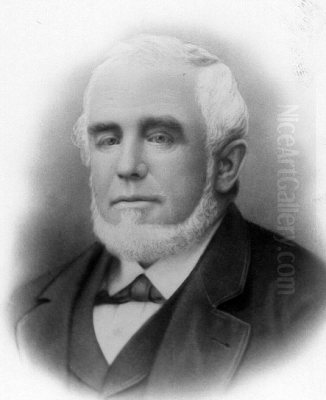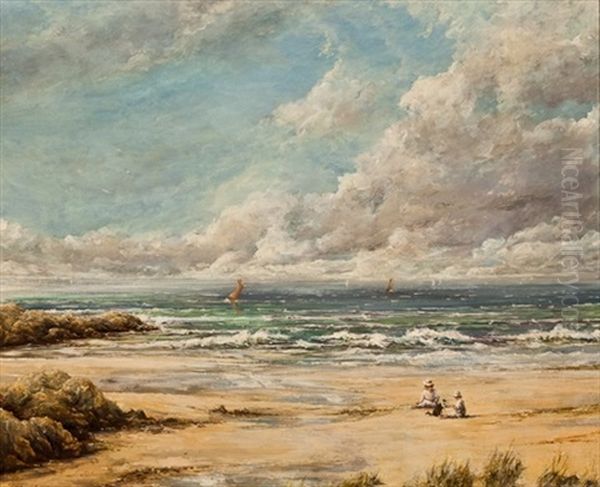
Joseph Henderson stands as a significant figure in the rich tapestry of Scottish art during the latter half of the nineteenth and the early twentieth centuries. Born in 1832 and passing away in 1908, his long and productive career witnessed substantial shifts in artistic tastes and techniques. Henderson navigated these changes with skill, establishing himself initially as a sought-after portraitist before gaining wider renown for his evocative marine paintings and landscapes, which captured the unique character of Scotland's coasts and waters. His connection to the burgeoning art scene in Glasgow further cemented his place in the annals of Scottish art history.
Early Life and Artistic Beginnings
Joseph Henderson's journey began in the small village of Stanley in Perthshire, Scotland, in 1832. Like many aspiring artists of his generation seeking greater opportunities and exposure, he eventually relocated to Glasgow. This move proved pivotal, placing him in the heart of Scotland's rapidly industrializing and culturally vibrant second city. While details of his earliest training can be sparse, it is likely he benefited from the established systems of art education available at the time, possibly including studies that emphasized drawing and foundational techniques essential for a career in the arts.
Glasgow, during Henderson's formative years and throughout his career, was a city undergoing immense transformation. Its wealth, derived from industry and trade, fostered a growing class of patrons interested in commissioning art, particularly portraits. Henderson capitalized on this environment, initially building his reputation through his skill in capturing likenesses. This early phase was crucial in establishing his professional footing and honing the observational skills that would later inform his landscape and marine work.
The Portrait Painter
In the initial decades of his career, Joseph Henderson distinguished himself primarily as a portrait painter. He found favour among the Scottish gentry and the prosperous mercantile class of Glasgow. His portraits from this period typically adhered to the conventions of Victorian portraiture, emphasizing a faithful representation of the sitter, often imbued with a sense of dignity and social standing. He possessed a keen ability to capture not just a physical likeness but also an element of the sitter's character.

His success in this genre provided him with financial stability and recognition within artistic circles. Commissioning a portrait by Henderson became a mark of status for many prominent families and individuals in and around Glasgow. While perhaps less dynamic than his later seascapes, these portraits demonstrate his solid technical grounding, his careful handling of paint, and his understanding of composition and form. Figures like Sir Henry Raeburn, the great Scottish portraitist of an earlier generation, had set a high standard, and Henderson operated within this tradition while developing his own distinct, if less flamboyant, style.
Transition to Landscape and Marine Art
While portraiture provided a steady income, Henderson's artistic inclinations increasingly drew him towards the natural world, particularly the dramatic coastlines and maritime life of Scotland. Over time, his focus shifted, and he became more widely celebrated for his landscapes and, especially, his marine paintings. This transition reflected a broader trend in British art, where landscape and seascape painting gained increasing popularity throughout the nineteenth century, partly inspired by Romanticism and later by Realist impulses.
He was particularly drawn to the western coast of Scotland, finding endless inspiration in its rugged shores, changing weather patterns, and the daily lives of its fishing communities. His canvases began to feature fishing boats returning to harbour, vessels navigating choppy seas under dramatic skies, or tranquil coastal scenes bathed in the soft light of dawn or dusk. This subject matter allowed him to explore themes of nature's power, human resilience, and the atmospheric beauty of the Scottish environment. His contemporaries in landscape included figures like Horatio McCulloch and Sam Bough, who also depicted Scottish scenery, though Henderson developed a particular affinity for the sea.
Artistic Style: Blending Realism and Atmosphere
Joseph Henderson's mature style is often characterized as a blend of Realism and Romanticism. His commitment to Realism is evident in the detailed observation of boats, rigging, coastal topography, and the human figure. He clearly studied his subjects closely, ensuring accuracy in representation. However, his work transcends mere topographical accuracy; it is imbued with a strong sense of atmosphere and mood, aligning him with Romantic sensibilities. He was particularly adept at capturing the effects of light and weather.

His handling of light is a key feature of his marine paintings. Whether depicting the harsh glare of midday sun on water, the diffused light of an overcast day, or the dramatic contrasts of a storm, Henderson skillfully used light and shadow to create depth and emotional resonance. His palette often reflected the specific conditions he was portraying, ranging from bright blues and greens for calm seas under clear skies to more sombre greys, browns, and deep blues for stormy weather. His brushwork, while generally controlled, could become more fluid and expressive when depicting moving water or turbulent skies, adding vitality to his scenes.
The Glasgow Art Scene
Having moved to Glasgow early in his career, Joseph Henderson remained a prominent figure in the city's art world for over half a century. Glasgow, by the late nineteenth century, had developed a distinct and energetic artistic identity, partly in reaction to the perceived conservatism of the Edinburgh establishment centered around the Royal Scottish Academy. Henderson, as an established and respected artist living and working in the city, inevitably played a role in this environment.
He was a regular exhibitor at the Royal Glasgow Institute of the Fine Arts, a key venue that showcased the work of local artists alongside national and international figures. His consistent presence at such exhibitions helped solidify his reputation and placed his work before the Glasgow public and potential patrons. His studio likely served as a meeting point, and his long career meant he witnessed the rise of younger generations of Glasgow artists, including those who would form the nucleus of the Glasgow School.
Connection to the Glasgow School
Joseph Henderson's relationship with the Glasgow School (often called the "Glasgow Boys") is one of association and influence rather than direct membership. The Glasgow Boys, a group that came to prominence in the 1880s and 1890s, included artists like James Guthrie, John Lavery, George Henry, E. A. Hornel, Arthur Melville, and James Paterson. They were known for their commitment to Realism and Naturalism, often painting outdoors (plein air), and their interest in decorative effects and bold brushwork, influenced partly by French Realism (like Jules Bastien-Lepage) and Impressionism.

Henderson belonged to an older generation, and his style, while evolving, remained generally more traditional than that of the core Glasgow Boys. However, his dedication to depicting Scottish scenes, particularly coastal and rural life, with a degree of realism and atmospheric sensitivity, certainly resonated with the younger artists' aims. He was a respected senior figure in the Glasgow art community during their rise. Artists like W. Y. Macgregor, often considered a leading figure among the Boys, and others such as E. A. Walton, Joseph Crawhall II, and David Gauld, would have been well aware of Henderson's work and his standing. He can be seen as part of the artistic milieu from which the Glasgow School emerged, contributing to the city's reputation as a centre for progressive painting, even if his own work did not fully embrace their more radical techniques.
Representative Works and Themes
While a comprehensive catalogue of his works is complex to assemble, several paintings exemplify Joseph Henderson's style and preferred subjects. Titles like "A Summer Breeze," "The Flowing Tide," "Low Tide," and "Fishing Boats at Anchor" point directly to his preoccupation with the sea and coastal life. These works often depict scenes along the Firth of Clyde or the Ayrshire coast, areas easily accessible from Glasgow. They typically feature fishing vessels – often the characteristic luggers or skiffs of the period – either at sea or moored in harbours.
His paintings frequently explore the interplay between human activity and the natural environment. Fishermen are often shown mending nets, preparing their boats, or navigating challenging waters, highlighting the labour and risks associated with their livelihood. Yet, the paintings are rarely purely documentary. Henderson infused these scenes with a palpable sense of atmosphere, capturing the specific quality of light, the movement of water, and the expanse of the sky. Works titled "Stormy Weather" or similar would showcase his ability to render the dramatic power of the sea, using dynamic compositions and expressive brushwork. His earlier portraits, such as the known "Portrait of Alexander Allan," demonstrate his competence in that genre as well.
Exhibitions, Recognition, and Memberships
Joseph Henderson achieved considerable recognition during his lifetime, exhibiting widely both in Scotland and England. He was a frequent contributor to the annual exhibitions of the Royal Scottish Academy (RSA) in Edinburgh and the Royal Academy (RA) in London, the most prestigious venues in Britain. His regular participation in the exhibitions of the Royal Glasgow Institute of the Fine Arts has already been noted. This consistent visibility ensured his work was known to critics, collectors, and fellow artists.
His standing was formally acknowledged through election to prominent artistic societies. He became a member of the Royal Scottish Society of Painters in Watercolour (RSW) in 1878, indicating his proficiency in that medium alongside oils. His connection with the establishment in Edinburgh was solidified when he was elected an Associate of the Royal Scottish Academy (ARSA) in 1881, followed by full membership as a Royal Scottish Academician (RSA) in 1886. These accolades confirmed his position within the mainstream of Scottish art. His work was acquired by public collections and private collectors, ensuring its preservation and continued appreciation.
Later Life and Legacy
Joseph Henderson remained active as a painter well into his later years, continuing to produce the marine and landscape scenes for which he was best known. He passed away in Glasgow in 1908, concluding a long and successful career that spanned over five decades. His death marked the end of an era for an artist who had witnessed significant changes in the art world, from the height of Victorianism to the dawn of Modernism.
His legacy lies primarily in his contribution to Scottish marine painting. He captured the beauty and drama of Scotland's coastline with sensitivity and skill, creating works that resonated with the public's appreciation for their national landscape. While perhaps not an innovator on the scale of the Impressionists or the core Glasgow Boys, Henderson was a highly competent and respected artist who excelled within his chosen genres. He helped maintain a strong tradition of representational painting in Scotland, focusing on local subjects rendered with atmospheric depth. His work provides valuable insight into the maritime life and coastal landscapes of late nineteenth-century Scotland. Artists like William McTaggart, another great Scottish sea painter, explored similar themes with perhaps greater expressive freedom, but Henderson's contribution remains distinct and significant. His long presence in Glasgow also contributed to the city's vibrant artistic culture.
Conclusion: An Enduring Scottish Artist
Joseph Henderson occupies a respected place in the history of Scottish art. As a skilled portraitist, he documented the society of his time, while his later, more celebrated career as a marine and landscape painter saw him capture the essence of Scotland's coastal environment. His ability to blend realistic detail with atmospheric effect created evocative images of the sea, weather, and maritime life that found enduring appeal. Although associated with the Glasgow art scene and contemporary to the Glasgow Boys, his style maintained a more traditional footing, bridging Victorian sensibilities with the growing interest in naturalism. Through his prolific output, regular exhibitions, and respected standing within institutions like the RSA and RSW, Joseph Henderson made a lasting contribution, particularly enriching the tradition of Scottish marine painting. His works remain appreciated today for their technical accomplishment and their affectionate portrayal of Scotland's shores and seas.